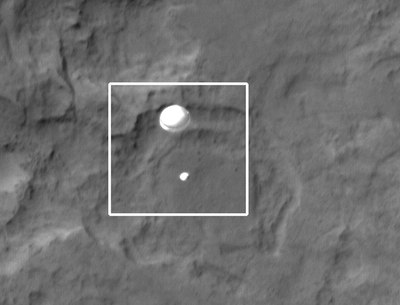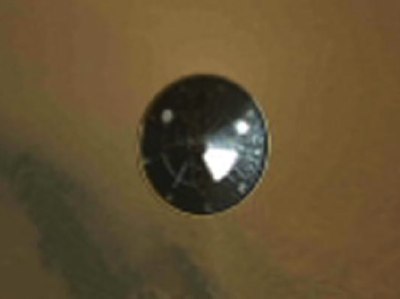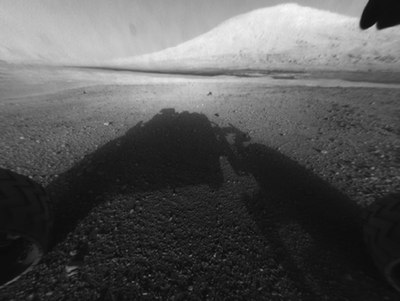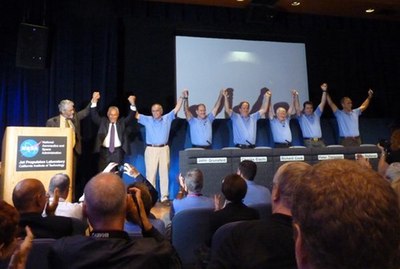From terror to triumphby Jeff Foust
|
| “It’s tough. It’s the most challenging landing that we’ve ever attempted,” said McCuistion. |
NASA famously illustrated that risk in a video titled “Seven Minutes of Terror”, a reference to how long it would take MSL to go from the upper fringes of the Martian atmosphere to touching down on the surface. With interviews with MSL team members, coupled with animations of the reentry and a dramatic, theatrical soundtrack, the video became a hit, attracting nearly 1.4 million views on YouTube.
In the briefings leading up to Sunday night’s landing, project and other NASA officials also emphasized the risks. “It’s tough. It’s the most challenging landing that we’ve ever attempted,” said Doug McCuistion, director of NASA’s Mars Exploration Program, at a briefing Saturday morning at JPL. He warned, at that press conference and other briefings leading up to the landing, that there was a risk the landing would fail. If so, he said, “we’ll pick ourselves up, we’ll dust ourselves off, we’ll look at this and do something again. This will not be the end.”
McCuistion, though, had declined prior to the landing to quantify the chances of success. “I don’t think there’s a single number we can put on this,” he said. “We’ve collectively agreed that this is as low a risk a proposition as possible, but it’s almost impossible to put a single number on the probability of success from the top of the atmosphere to the bottom.” (As it turns out, they had put out such a number: just a 1.7% chance of failure if the hardware worked as planned, Nature reported earlier in the week.)
Adam Steltzner, the gregarious JPL engineer who led the EDL phase of the mission, had accepted the risks of possible failure by Sunday morning, when there was little the team could do to rectify any problems anyway. “I slept better last night that I have slept in a couple of years, because she’s kind of on her own now,” he said. (He refers to Curiosity in the female gender because, as he put it later in that morning press conference, “She seems like a she.”) “When I look back at the hard work that we’ve done, we’ve done everything that we can to deserve success tonight, although as we all know, we cannot guarantee success.”
Not that he wasn’t at least a little nervous. “We’re rationally confident, emotionally terrified, and ready for EDL,” he said that morning.
Complicating matters was the risk of a problem that has nothing to do with MSL itself. The mission planned to use NASA’s Mars Odyssey spacecraft as a communications relay, transmitting data during EDL in “real time” (except for the 14-minute light travel time from Mars to Earth.) However, the aging Odyssey spacecraft, launched in 2001, suffered a failure two months earlier of a reaction wheel used to orient the spacecraft. Odyssey switched to a backup reaction control wheel, but project officials said they were unsure what would happen Sunday night when they commanded the spacecraft to “roll” so that it would be properly oriented to receive MSL’s transmissions. If Odyssey was not available, the team would have to wait hours for two other orbiters, Mars Reconnaissance Orbiter (MRO) and ESA’s Mars Express, which collected telemetry but could not provide real-time retransmission, to broadcast the stored data back to Earth.
| “We’re rationally confident, emotionally terrified, and ready for EDL,” Steltzner said the morning of the landing. |
“We’re still learning about how this spacecraft operates in a different momentum configuration than it’s had previously,” McCuistion said Sunday morning. “We think we have it nailed, but there is still a bit of risk of rolling the spacecraft into this new configuration.” Later, he sounded confident it would not be an issue. “It’s been going great for weeks now, the team’s done a great job with it, so I think we’ll be okay.”
But when the time came Sunday night, there was no sign of the terror that NASA warned everyone about. Shortly before MSL began the critical EDL phase of its mission, Odyssey flawlessly maneuvered into position to serve as the communications relay. Then, with that data link established, the MSL team—sitting at consoles in mission control but serving as observers rather than controllers now, unable to help MSL if it had a problem—followed the telemetry. There was tension, but no terror. That tension was relieved, bit by bit, as the spacecraft stayed on course, with cheers and applause as it hit several milestones, such as the deployment of its parachute and, later, the firing of its descent engines.
 An image taken by the HiRISE camera on the MRO spacecraft shows MSL descending under its parachute shortly before the rover reached the surface. (credit:NASA/JPL/University of Arizona ) |
At a press conference Saturday, one reporter asked how we—the media and, by extension, the public—would know when Curiosity was safely on Mars. He was seeking some sort of official announcement, but MSL deputy project manager Richard Cook offered a better sign: “You’ll probably be able to tell by us celebrating.” At about 10:31 pm Pacific time Sunday night, it was clear from anyone watching the video feed of the MSL mission control room that the rover was on the surface.
That celebration continued 45 minutes later at the post-landing press conference at JPL, which took on more on at atmosphere of a rally than a question-and-answer session with reporters. Besides the key mission managers, NASA administrator Charles Bolden, and White House science advisor John Holdren, what looked to be the whole MSL team at JPL, wearing matching light blue polo shirts, paraded through the auditorium to cheers, handshakes, and hugs. At one point JPL director Charles Elachi was reduced to being something like a junior high principal imploring for calm at a school assembly, trying to clear the stage so the press conference could begin.
| Monday afternoon, MSL mission manager Jennifer Trosper was asked if there was anything that wasn’t going according to plan with Curiosity so far. Her one-word response: “No.” |
Of course, so soon after landing there wasn’t much additional news that the team could provide beyond the fact that the rover was safely on the ground in Gale Crater. “It looked extremely clean,” Steltzner said of the landing. Conditions at the landing site were benign and the spacecraft’s navigation error was “remarkably good.” The spacecraft landed with 140 kilograms of propellant to spare, out of an original supply of 400 kilograms.
More details about the landing came out in two separate press conferences on Monday, both of which reinforced the perception that the mission has gone—at least so far—as close to textbook as possible. “I hope you enjoyed the roller coaster ride last night,” Miguel San Martin, the chief engineer of guidance and control for MSL said at a Monday morning press conference. “EDL looked beautiful from our monitors.” Monday afternoon, MSL mission manager Jennifer Trosper was asked if there was anything that wasn’t going according to plan with Curiosity so far. Her one-word response: “No.”
At that briefing, San Martin said the rover landed very close to the center of its landing ellipse within Gale Crater, about two kilometers east and a few hundred meters north of the center. That landing point was refined further later Monday, when Mike Malin, principal investigator of MSL’s Mars Descent Imager (MARDI) camera, compared images taken by the downward-facing camera during the rover’s descent with images taken of the area before landing by the High Resolution Imaging Science Experiment (HiRISE) camera on MRO.
Both HiRISE and MARDI provided some early stunning images as well. Monday morning NASA released a HiRISE image of MSL during descent, with its parachute deployed. HiRISE had taken a similar image during the landing of the Phoenix Mars Lander in 2008, but HiRISE investigation scientist Sarah Milkovich said this was harder because of the relative positions of MSL and MRO. “The team internally guesstimated that, for Phoenix, they had an 80 percent chance of getting that image, and on MSL it was a 60 percent probability. So this was a great, great shot.”
By Monday afternoon the HiRISE team has also found MSL’s heat shield, jettisoned from the spacecraft before the image was taken, in the same frame. Better images of the heat shield, though, came from MARDI, as Malin showed a series of images from heat shield jettison down to landing; some, for example, showed clouds of dust picked up by the thrusters on MSL’s skycrane as it approached the surface.
 An image from the MARDI camera on Curiosity shows the heat shield falling away from the spacecraft during its descent. (credit: NASA/JPL-Caltech/MSSS) |
The MARDI images were a long time coming for Malin, who had a similar camera on the failed Mars Polar Lander and another on the Phoenix Mars Lander that was not used out of concerns that a hardware problem with the spacecraft could have caused a loss of critical engineering data had it been operated. “This press conference is occurring 12 years and 8 months after when I originally thought I’d be telling you about this type of images,” he said, referring to the date of the Mars Polar Lander crash.
The MARDI images joined those returned by the hazard avoidance, or Hazcam, images taken by the rover immediately after landing. The rear-facing Hazcam images show what appears to be the wall of Gale Crater, 28 kilometers away, while the front-facing Hazcam image shows the mountain at the heart of Gale Crater (officially designated Aeolis Mons by the International Astronomical Union, but usually, if unofficially, called Mt. Sharp by the project team, using a name that predated the IAU designation) whose base is 6.5 kilometers away.
The science from the Curiosity rover will come slowly, in part because of a lengthy checkout process to make sure the rover and its suite of instruments are working properly. By early September Curiosity will be ready to move for the first time—a short drive of just a meter or two—assuming everything goes, as it has so far, as planned. “We’re in no hurry,” Peter Theisinger, MSL project manager, said at the post-landing press conference, calling Curiosity a “priceless national asset” that they wanted to be careful with. “We will, with a slow, deliberate, methodical pace, begin the science explorations the science team wants to take.”
| Why did everything go according to plan—or, rather, why are we surprised that it went according to plan? Was the MSL team really that good, or were they lucky, or perhaps some combination of the two? |
Theisinger and others feel comfortable with taking their time, since the rover has a much longer planned lifetime than any previous rover: a minimum of two years, with the hope of it lasting far longer, just as the rovers Spirit and Opportunity exceeded their 90-day lifetimes many times over. “The nominal mission for this is two years, but I think if it lasts twice that, I don’t think anyone would be shocked,” Theisinger said. “And that’s the first time anyone gotten me to say anything more than two years!”
That slow rampup of activities does have a drawback for NASA, as it will make it harder for the agency to capitalize on the outpouring of public interest in Sunday night’s landing, from a surge of activity online to a crowd that watched the landing on a giant video screen in Times Square in New York. As Curiosity and its team on Earth methodically check out the rover to prepare it for years of operations, the public’s attention will drift to other topics, from the conclusion of the Olympics to the November elections.
 An image from the Hazcam mounted on the front side of the rover shows the shadow the rover casts as well as, in the distance, the mountain Aeolis Mons, aka Mt. Sharp. (credit: NASA/JPL-Caltech) |
On the other hand, this time presents an opportunity to step back and reflect on the overwhelming success of the landing, one that created a high that, nearly 24 hours later, hadn’t really worn off. Why did the landing appear so much easier than what we were warned to expect? Why did everything go according to plan—or, rather, why are we surprised that it went according to plan? Was the MSL team really that good, or were they lucky, or perhaps some combination of the two? Perhaps, as Branch Rickey once said, “Luck is the residue of design.”
It’s something to keep in mind as we “dare mighty things”, to use the line from the end the “Seven Minutes of Terror” video, be they putting rovers on Mars, sending humans beyond Earth orbit, or other major deeds on space or on Earth. In an era of self-doubt and worries that we’re not as good as we once were, putting a one-ton rover on the surface of a planet hundreds of millions of kilometers away, and doing so almost exactly as planned, should remind us that are best days are not behind us, and give us the confidence to go boldly into the universe.
